
Luck or coincidence? When we first launched our maiden Techsurvey in 2005, the timing turned out to be magnificent. The techie planets lined up, as the iPhone, Facebook, and YouTube (to name a few) came to market – and took off.
Amazing, right? Smartphones, social media, and video streaming all hit their stride right around the same time. And in their wake, the damage they did to traditional media outlets like newspapers, TV, and broadcast radio was the big story. And it continues to this day.
Of the traditional media, it’s hard not to give radio the nod for “Best Performance By Old Media.” Nielsen’s newest “Audio Today” reports reveals broadcast radio’s vital signs continue to be solid.

Overall, 92% of adults 18+ listen to the radio each week – higher than any other measured platform, including TV, personal computers, smartphones, TV-connected devices, and tablets. Not bad, right?
But despite radio more than holding its own, the landscape has become increasingly crowded. Disruption has become a naughty word in legacy media circles – the acknowledgment that new media and technologies are on their way to becoming mainstream.
A Harvard Business Review analysis by Thales S. Teixeira suggests the damage to old school media outlets has taken place due to unforced errors, rather than outside predators disrupting audiences.
In “Disruption Starts With Unhappy Customers, Not Technology,” Teixeira makes the case that it is consumers who make the decision to adopt – or reject – new platforms, products, and technologies.
Rather than simply jump into the next big digital category to try to answer disruption, Teixeira says companies would be better off with a renewed focus on addressing their customers’ desires and needs.
He goes on to make an impressive list of “incumbent” companies that were disrupted by an outside “predator.” In the video game space, Twitch has upended Electronic Arts. Netflix has wreaked havoc on Comcast, while Gillette has been damaged by Dollar Shave Club.
As you might expect, radio doesn’t get a mulligan. He points to iHeartRadio as the brand that’s been disrupted by Pandora. But he could have also mentioned any radio broadcaster as “disruptee,” as well as satellite radio, podcasting, Spotify, and myriad other as “disruptors.”
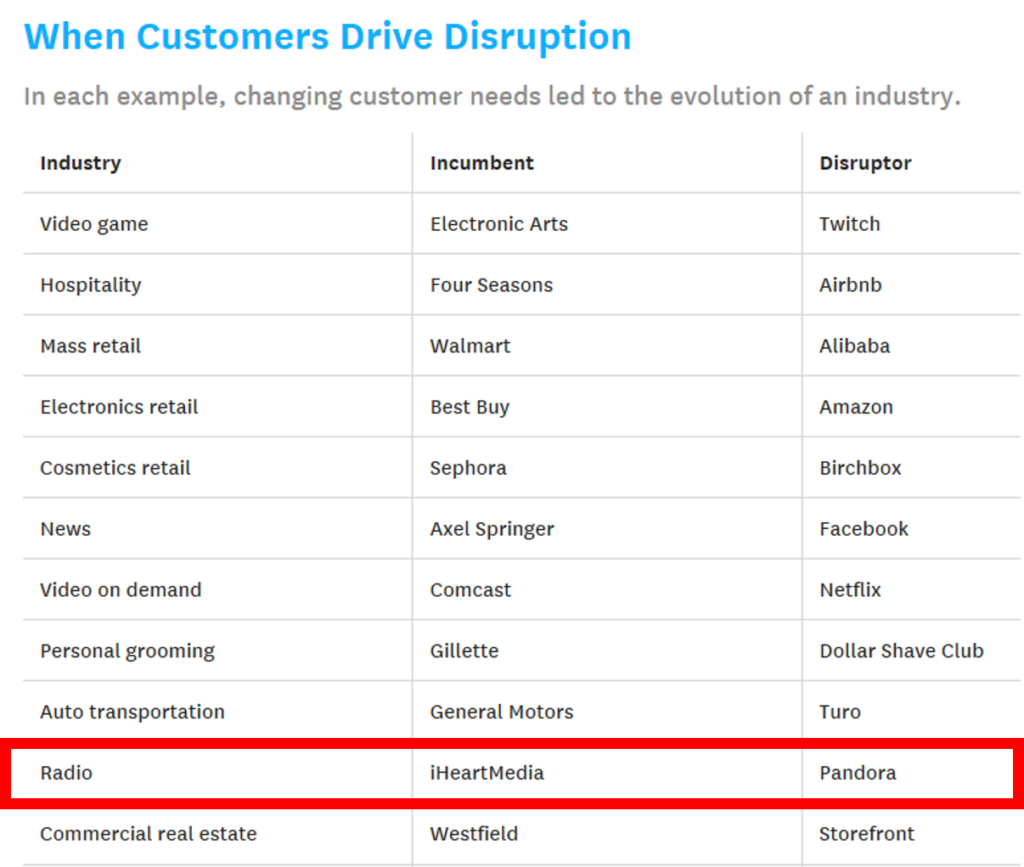
So, what can legacy brands do to stave off the many predators in their digital midst, as well as ensure it’s connecting and pleasing its consumer base?
Teixeira calls it a “customer side focus,” and the concept is to determine how to provide benefits to users via new products or improvements to existing ones. And Teixeria suggests creating new offerings “adjacent” to activities (radio listening) can provide success.
Many stations (and the companies that own them) are on this path, working on streams, podcasts, and videos that complement the main brand. But he warns that when traditional businesses – like radio broadcasters – focus on their own benefits, rather than turning the emphasis on consumers, it’s easy to fail.
I thought about this last week while in an Uber in Florida driven by a guy named Mario. I have become a regular user of Uber (or Lyft), not because I love the company, but because I was driven away by the traditional business model – the taxicab industry.
How frequently do travelers encounter a rude or indifferent cab driver or one that spent the entire ride on the phone or playing his favorite radio station or personal playlist at loud levels? Too often, those video screens in the back seat are blaring ads and other useless information, often impossible to mute. Then, there’s the randomness of hailing a cab or hoping the driver knows how to find your destination. And then there’s payment – another clunky process that slows down the journey.
So, was the taxicab industry disrupted by Uber? Or did it alienate its customers to the point where when a better alternative arrived they took it?
I realize there are aspects to the Uber/Lyft experience that have been less than ideal, but while sitting in the backseat of Mario’s Toyota Camry (with cup holders!), I started looking around. It turns out Mario isn’t just a good driver – he’s focused on customer service.
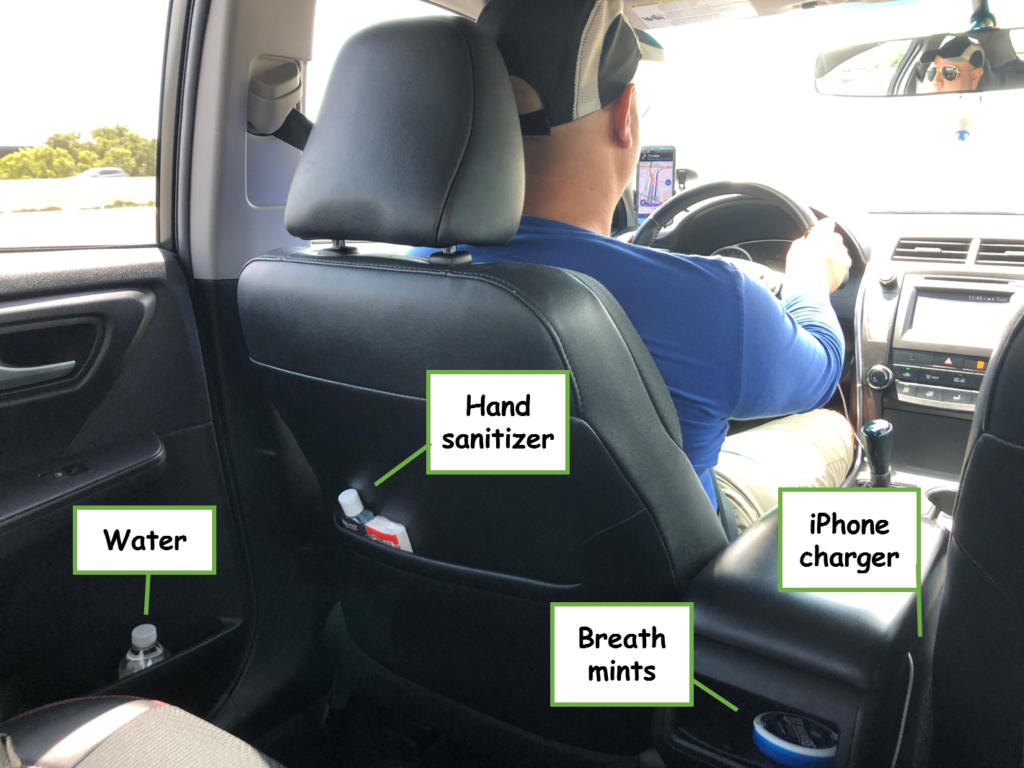
Everything I could have possibly wanted (except for the New York Times crossword puzzle) was within reach. Never ever have I seen the back seat of a New York hack with these basic amenities.
But it wasn’t about breath mints or hand sanitizer. It was that Mario considered and respected his customers’ needs. It told me this guy cares more about service than the hundreds of taxi drivers I’ve encountered over the decades.
I wouldn’t be in the Uber zone if the taxi industry hadn’t driven me away, leaving me vulnerable to smart, new competitors trying to solve my problems and meet my needs.
And so, when you think about what core radio listeners are trying to tell us, it is about self-inflicted wounds. Sure, disruption plays a role, too. But those time-honored radio negatives – commercial load and music repetition – are right near the top of the list of reasons why people gravitate away from radio.
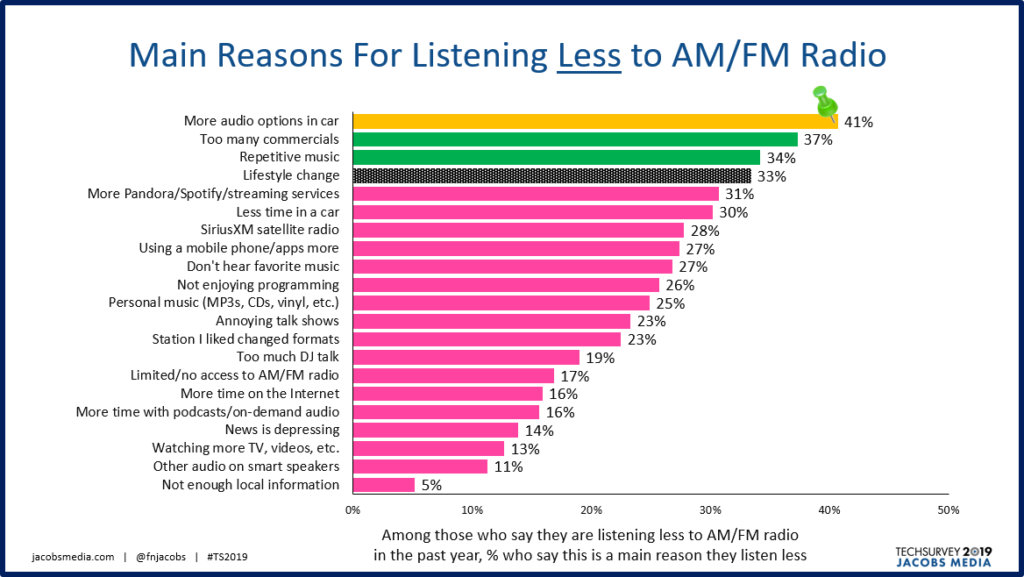
Yes, “more audio options” in the car is mentioned by four in ten of those listening less to radio. But the age-old negatives – commercials and repetition – continue to be culprits.
Radio veterans can sneer at those findings as being “just typical listener complaints.” But when you think about the ways in which disruptors from Pandora to SiriusXM address both problems, Teixeira’s points are well taken.
When I think about that relentless attention on the customer, as well as that “side focus,” Jeff Bezos comes to mind. As he has said time and time again:
“We’re not competitor obsessed, we’re customer obsessed. We start with what the customer needs and we work backwards.”
To make that point, Bezos used a fascinating device during Amazon’s early strategy meetings. He’d drag in an empty chair, and informed his team 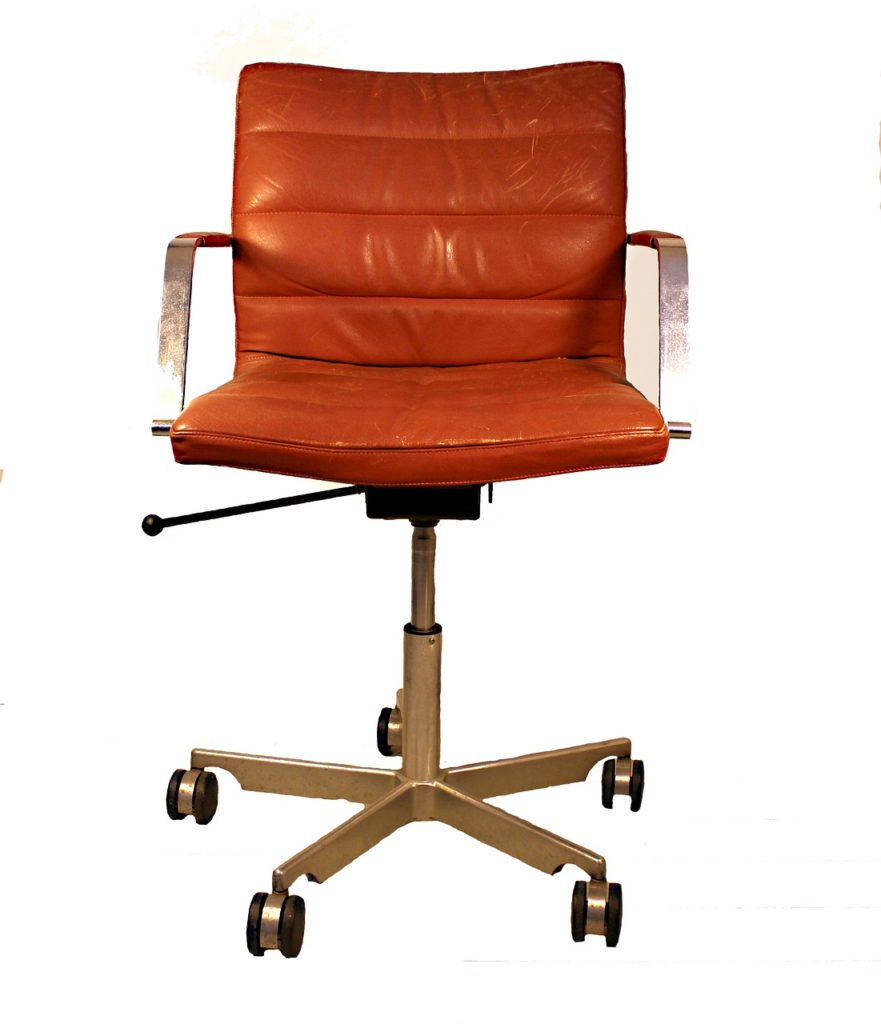 that seat was “the customer.” As they worked through their agenda, there was always that focus on the end user of the Amazon product.
that seat was “the customer.” As they worked through their agenda, there was always that focus on the end user of the Amazon product.
Bezos believes that “Focusing on the customer makes a company more resilient.” And I would make the case that same focus makes an industry more resilient.
“Resilience” is becoming a buzzword in the world of business. Last year, CES started its own track of sessions and speakers revolving around this concept.
For radio broadcasters, it’s about analyzing research – whether it’s Techsurvey, perceptual studies, or focus groups – and really listening to listeners. For years, they’ve been telling us what’s wrong. And for years, we’ve been telling ourselves, they always complain about the same old things. Or that our “business model” is dependent on 12 minutes of commercials an hour.
And now, radio is surrounded by an armada of disruptors. Is it that others are coming up with better technology or is that radio broadcasters would serve themselves and their audiences better by embracing customer needs, wants, and desires.
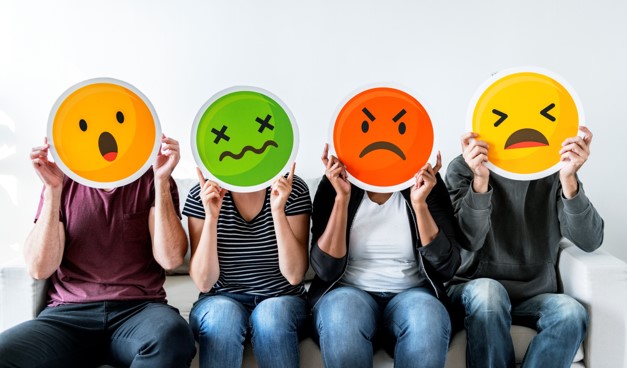
That’s why my favorite customer service quote is from Bill Gates who reminds us:
“Your most unhappy customers are your greatest source of learning.”
When we stop all the hand-wringing over disruption, and focus on our listeners, radio will once again be what resilience is truly all about.
- What To Do If Your Radio Station Goes Through A Midlife Crisis - April 25, 2025
- A 2020 Lesson?It Could All Be Gone In A Flash - April 24, 2025
- How AI Can Give Radio Personalities More…PERSONALITY - April 23, 2025




Nailed it!!!!
Thank you, Fred, for distilling this down to a concise and actionable prescription for positive change. These are paradigm shifts worthy of consideration, as they present inherent disruption and competitive advantages in the here and now.
Well done, sir.
Peter Drucker On Marketing. … “Because the purpose of business is to create a customer, the business enterprise has two–and only two–basic functions: marketing and innovation. Marketing and innovation produce results; all the rest are costs. Marketing is the distinguishing, unique function of the business.”
During radio’s consolidation, it lost its focus on the customer. That is a bigger disruption than technology.
And what attracted listeners were the personalities, as I wrote in a blog two weeks ago. Here’s a the link to that article: https://dicktaylorblog.com/2019/06/02/is-radio-being-disrupted-or-simply-lacking-the-human-factor/
And how do you know what the customer wants? ASK THEM.
And that’s just what Techsurvey has been doing since 2005. Now all that’s needed is for the radio industry to listen to what the people are saying.
Thank You Fred & Paul
Loved your blog, Dick, thanks for sharing! The line that resonated with me most was, “The aspect of radio that first captured my attention was the radio personality.”
When I think back on my favorite stations, it was the PEOPLE that I always came back for. Sure, any number of stations might play my favorite song, and some stations might do a better job of playing MORE of my favorite songs than others, but in the end it was always the people that made for “must hear” radio listening.
Just ask the people who love Howard Stern. Or the people who hate him.
Thank You Dave for your kinds words. My love of radio begins and ends with the radio personalities. I can get the music from so many sources today. But a great personality separates the wheat from the chaff, so to speak.
I would be interested to see TSLs for radio and disrupters alike. If we are still getting 90 percent of the audience are they sticking around or just zipping through before they hit their podcast or commercial free music? How can the radio model of advertising change so that we can use digital and NTR instead of traditional 60 30 or 15 ads? In an age of promotions departments being phased out how do you get in front of your listeners with the personalities of the station and not street teams? I can tell you that I do it by volunteering or hosting charity events around my area. I find it confusing that radio is the business of advertising, but many stations are unwilling to spend a dime on TV, billboards or digital themselves. Help me Obi Wan…
Amelia, a lot to unpack here, but I’ll try. You are spot on that TSL (or engagement) is quite a bit different than reach (cume). And as promo departments are stripped or shelved, it makes it much more difficult to engage with fans. You’re smart to continue to interface with your community whether those appearances are paid or unpaid. You’re building both the 98Rock brand AND the Amelia brand. Both are important. And finally, you’ve hit on the ultimate contradiction – how can we tell clients to market their businesses when we’re unwilling to do the same for our own. I’m still working on that one. Thanks for the comment.
I love this Fred!
How many personas does your station have?
We measure in P-1, P-2, and so forth, but those are not passion personas, they are user personas.
We still see research from people that say “I just want to hear music in the morning!”
Those are not customers, those are users. It’s like trying to win customers with lower prices, its losing game. Again, those are not customers, those are users. No one ever feels good in a relationship with a user.
Arbitron warned a decade ago that listeners were losing passion for radio, as radio stopped doing the things that made people passionate about the station.
Do more of what “customers” love, and you’ll have more passionate customers.
It’s so simple, right? But we get so caught up in the ratings game, we lose sight there are fans out there – not meters or diaries. Thanks for the note, Gene, and lending me your and Julie’s cheery faces on the Echo Auto post.
The listener’s seat at the table should be filled by the program director. The PD has no greater responsibility than to represent the voice of the customer inside the walls of the radio station.
Keith, that’s a good way to look at it. Appreciate your comment.
Well written as always Fred. Just yesterday I commented on a FB group about 15 unit commercial break in middays in a competitor. You can guess the name of that competitor. Hard to believe a 15 unit stop set is “customer focused” in any sense of the term. “We have met the enemy, and it is us.”
No doubt about it, Rick. Great to hear from you & thanks for reading our blog.
A simple non-sectarian “Amen” will do….
When I started in this business decades ago, the stations I worked at and programmed used to take pride in creating entertaining commercials for our customers. I once did a spot for a local pizza restaurant that was giving away yo-yos with every purchase of a large pie. For some reason, my mind thought voicing the spot in a bad impression of W.C. Fields (emphasizing the *second* syllable of “yo-yo”) backed up by an offbeat production library music track, was a good idea.
Did I say “good”? The account exec liked it, the client loved it, and the buy increased in amount.
I subscribe to Jerry ‘s online Radio And Production e-zine, and every issue includes composite of past years’ commercials and promos. What I realize in hearing those is that I rarely hear anything near as creative on the radio today.
And I cannot lay the blame on increased agency buys (living in market #2, I hear almost entirely national spots), because they used to produce some very entertaining stuff, too: I remember a spot in the late 1970s for Round Table Pizza about the training of a new hire who had worked at a competing chain… “Okay, first we start with the pizza dough.” “Go to the freezer, get the box.” “No, we make our dough fresh every day.” It went on like that for cheese, toppings, etc. Everything was met with the doofus character voice “go to the freezer, get the box” until finally the trainer, exasperated, asked “Did they use frozen sauce at that other place.” “Nope.” “Okay, then …” “Go to the shelf, get the can.”
40 years ago and I still remember the commercial AND who it was for. Why can’t we create memorable spots now? Make the stopsets as entertaining as the format and listeners will stop calling those “interruptions”. (And our clients will benefit too.)
KM, that’s a tall order, but not an unimportant one. Aside from the fact commercials are the key marketing tool radio uses to service its advertisers. And of course, they make up perhaps 16-20% of each hour. Thanks for the reminder.
Love that, K.M.! And yes, I remember radio spots from my childhood as well–so it can be done! Question is, do we invest the time and energy to create memorable, effective spots…or do we “go to the shelf, get the can…”
12 minutes?! That would be relief. But you’re dead-on. We used to find out what they (listeners) wanted through research and served it up to them on a silver platter. Not much budget for research – or silver platters these days.
Sadly, no. But there are ways to use cheap/free tools (Survey Monkey, LAB groups) to at least learn SOMETHING. It is amazing, Andy, that we were much more disciplined back then, making sure we had an understanding of the landscape. Thanks for the comment.